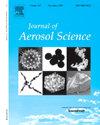介质真空中真空紫外辐射的质荷比纳米颗粒尺寸分布测量方案
IF 2.9
3区 环境科学与生态学
Q2 ENGINEERING, CHEMICAL
引用次数: 0
摘要
随着半导体制造业对虚拟计量(VM)和先进过程控制(APC)的需求不断增加,过程结果的原位定量监测的重要性已经超越了原位定性监测。粒径分布(PSD)分析范围从几纳米到数百纳米(nm)直径的纳米颗粒提供了一种可能的方法来定量监测等离子体过程。然而,为PSD分析设计的传统粒子束质谱仪(PBMS)系统需要大于数百毫微的压力才能运行,这限制了它们在需要介质真空的现代半导体工艺中的适用性。我们提出了一种新的PSD测量方案,用于中真空过程的PSD分析。硬件配置包括真空紫外(VUV)辐照室和由堆积式四极杆带电粒子漏斗和四极杆质量分析仪(QMA)组成的质荷比(m/q)测量装置。在此基础上,采用梯度下降优化的基于直接光电离模型的非负最小二乘(NNLSQ)方法开发了PSD测量算法。PSD是根据在不同紫外辐射水平下测量的多个m/q分布估计的。仿真结果表明,所提出的m/q测量方案对粒径为5 ~ 50 nm的单电荷球形氯化钠(NaCl)纳米粒子的m/q选择效率为21%,分辨率为±3%,这些纳米粒子在20°C的自由分子区服从麦克斯韦速度分布。此外,在理想的光离优势条件下,随机分配初始电荷的NaCl纳米粒子,峰归一化目标单分散psd的分布变化斜率为- 0.4 ~ 0.5 nm - 1,尺寸范围为5 ~ 50 nm,模误差在5.6%以内,几何标准差(GSD)误差在2.0%以内。本文章由计算机程序翻译,如有差异,请以英文原文为准。
Nanoparticle size distribution measurement scheme using mass-to-charge ratio measurements with Vacuum Ultraviolet irradiation in medium vacuum
With increasing demand for Virtual Metrology (VM) and Advanced Process Control (APC) in semiconductor manufacturing, the importance of in-situ quantitative monitoring of process results has grown beyond in-situ qualitative monitoring. Particle Size Distribution (PSD) analysis of nanoparticles ranging from several to hundreds of nanometers (nm) in diameter offers a possible method for the quantitative monitoring of plasma processes. However, conventional Particle Beam Mass Spectrometer (PBMS) systems designed for PSD analysis require pressures greater than hundreds of millitorrs for operation, which limits their applicability to modern semiconductor processes that require a medium vacuum. We propose a new PSD measurement scheme to perform PSD analysis for medium-vacuum processes. The hardware configuration includes a Vacuum Ultraviolet (VUV) irradiation chamber and a mass-to-charge ratio () measurement device consisting of a stacked-quadrupole-based charged particle funnel and Quadrupole Mass Analyzer (QMA). With this configuration, a PSD measurement algorithm is developed using a direct photoionization model-based Non-negative Least Squares (NNLSQ) method with gradient descent optimization. The PSD is estimated from multiple distributions measured under various VUV irradiation levels. The simulation results demonstrate that the proposed measurement scheme achieves an selection efficiency of 21% and a resolution of ± 3% for singly charged spherical Sodium Chloride (NaCl) nanoparticles at the sizes of 5–50 nm, which follow Maxwellian velocity distributions at 20 °C in the free molecular regime. Furthermore, under ideal photoionization-dominant conditions for NaCl nanoparticles with randomly assigned initial charges, peak-normalized target monodispersed PSDs with distribution change slopes ranging from 0.4 to 0.5 can be estimated in the size range of 5–50 nm, with mode errors within 5.6% and Geometric Standard Deviation (GSD) errors within 2.0%.
求助全文
通过发布文献求助,成功后即可免费获取论文全文。
去求助
来源期刊

Journal of Aerosol Science
环境科学-工程:化工
CiteScore
8.80
自引率
8.90%
发文量
127
审稿时长
35 days
期刊介绍:
Founded in 1970, the Journal of Aerosol Science considers itself the prime vehicle for the publication of original work as well as reviews related to fundamental and applied aerosol research, as well as aerosol instrumentation. Its content is directed at scientists working in engineering disciplines, as well as physics, chemistry, and environmental sciences.
The editors welcome submissions of papers describing recent experimental, numerical, and theoretical research related to the following topics:
1. Fundamental Aerosol Science.
2. Applied Aerosol Science.
3. Instrumentation & Measurement Methods.
 求助内容:
求助内容: 应助结果提醒方式:
应助结果提醒方式:


